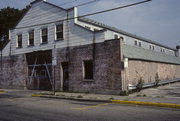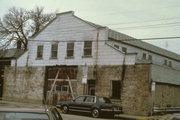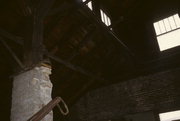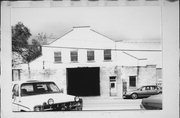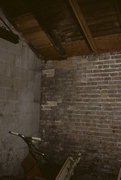Property Record
121 S WEBB AVE
Architecture and History Inventory
| Historic Name: | J.W. Corwith Livery (Feed Barn) |
|---|---|
| Other Name: | BERNIEN COMPANY |
| Contributing: | |
| Reference Number: | 61158 |
| Location (Address): | 121 S WEBB AVE |
|---|---|
| County: | Sauk |
| City: | Reedsburg |
| Township/Village: | |
| Unincorporated Community: | |
| Town: | |
| Range: | |
| Direction: | |
| Section: | |
| Quarter Section: | |
| Quarter/Quarter Section: |
| Year Built: | 1911 |
|---|---|
| Additions: | |
| Survey Date: | 1983 |
| Historic Use: | livery |
| Architectural Style: | Commercial Vernacular |
| Structural System: | |
| Wall Material: | Brick |
| Architect: | |
| Other Buildings On Site: | |
| Demolished?: | No |
| Demolished Date: |
| National/State Register Listing Name: | Corwith, J. W., Livery |
|---|---|
| National Register Listing Date: | 4/20/2004 |
| National Register Multiple Property Name: | Multiple Resources of Reedsburg |
| Additional Information: | The Corwith Livery and Feed Barn is a rectangular building constructed of Chicago brick. It has a 60' frontage on Vine Street and extends north 160' to the alley. The livery is one story with a monitor roof covered with asbestos shingles, although was once clad with metal. The sides of the monitor roof are faced with metal stamped to look like brick. The south facade has a parapet roofline and four bays of 4/1 vertical pane windows on the upper section. A large door, for carriage or car entry, is centered on this facade. A door on the east part of the south facade is wood and has a scrolled design on it and an overlight above. This used to lead into a ladies waiting room and office. All that remains of this is a concrete slab; all partition walls are gone. The interior of the building reveals solid brick walls with a wood frame roof and beams. The rear third of the building has been blocked off and is used as a workroom, the front or south of the building is used for storage. Although the side of the livery has had many of the windows bricked over, the building has retained its essential integrity. The livery is now attached to a later twentieth century building on the northwest corner. The new section, fronting South Webb Avenue, is a non-contributing element as far as the historic significance of the livery is concerned. The livery itself was built by Johnson Lumber Company of Reedsburg while Sweeney Brothers, also of Reedsburg, did the cement work. (The addition at 121 S. Webb Ave. is now used for storage by Bernien Company (tractor sales). Bernien also used the old (c. 1911) livery facing 121 Vine Street for storage and work space. The store itself is at 121 S. Webb Avenue. The company was founded by John Bernien c. 1892. It sold farm implements then. Although Reedsburg had only a few liveries throughout the nineteenth and early twentieth centuries, the liveries, whether run in connection with a hotel or operated separately, were an important part of the commercial life of the community. They transported people to and from a depot and between other locations, provided a personal service by caring for horses and carriages, and often bought and sold horses on special request. All this occurred at a time when horses and carriages were a main form of transportation both inside the city and for longer distances. Only the railroad could provide a faster mode of transportation. In 1911 William Corwith built this livery and feed barn. He had been in the livery and feed business about one year and had a "first class up-to-the-times livery." In addition to the building extant, Corwith had a 90' x 30' barn east of it (gone). He could accommodate 120 horses and had 19 for livery use, in addition to buying and selling horses. In 1925 Corwith had 27 horses, stable room and carriage room. A large part of his business was then concerned with funerals, weddings and private parties. Corwith's livery was built west of the Bates Hotel (gone) on Vine Street, south of the City Hotel at 125 Main Street, one block southwest of the Hotel Stolte at 204 Main Street, two blocks southeast of the railroad passenger depot, and near the southwest edge of the commercial district. Residences and warehouses are also nearby. This was a central location as far as potential business was concerned. Three liveries were operating in Reedsburg c. 1912 when "It was predicted with the incoming of automobiles that the livery business would be out of commission as a profitable vocation, but such has not proved the case. Automobiles seem rather to have stimulated the business by introducing riding to people who otherwise might never have become converts. People ride for business and pleasure more now than ever before, so we find livery men prospering." In 1924, 20 years after the first automobile had arrived in Reedsburg, they were still considered a rarity in the city, although livery barns were now beginning to be used for automobile storage also, including the Corwith Livery. The J.W. Corwith livery and feed barn has local historical significance because of its association with the development of transportation in Reedsburg. It provided an important commercial function in the city by servicing horses and carriages and providing a basic form of transportation, all of this before the popularity of the automobile changed transportation styles. In addition to its service function, the livery represents what was once one of the focal points of the community's transportation system (another being the railroad). The Corwith Livery is the last extant structure in Reedsburg associated with this important form of turn of the century transportation. Because of its high degree of integrity, the livery is an excellent physical representation of transportation history in Reedsburg and has historic significance. |
|---|---|
| Bibliographic References: | (A) The Reedsburg Times, April 21, 1911. (B) Wisconsin Industrial Review, March 1912 (Vol. XIII, No. 147). (C) Sanborn-Perris Maps. (D) French, Mrs. Bella (ed.), History of Reedsburg, Wisconsin 1875, an issue of the American Sketchbook (LaCrosse, Sketchbook Company, 1875). (E) Dwinnell, Solomon A., Sauk County, Town of Reedsburg. This was written in 1872 and reproduced in 1980 by Donald V. Hyzer, Reedsburg. (F) Bensel, A.A., Bensel's Sauk County Directory (Fond du Lac, P.B. Haber Printing House, 1890). (G) The Reedsburg Times, December 19, 1924. |
| Wisconsin Architecture and History Inventory, State Historic Preservation Office, Wisconsin Historical Society, Madison, Wisconsin |

